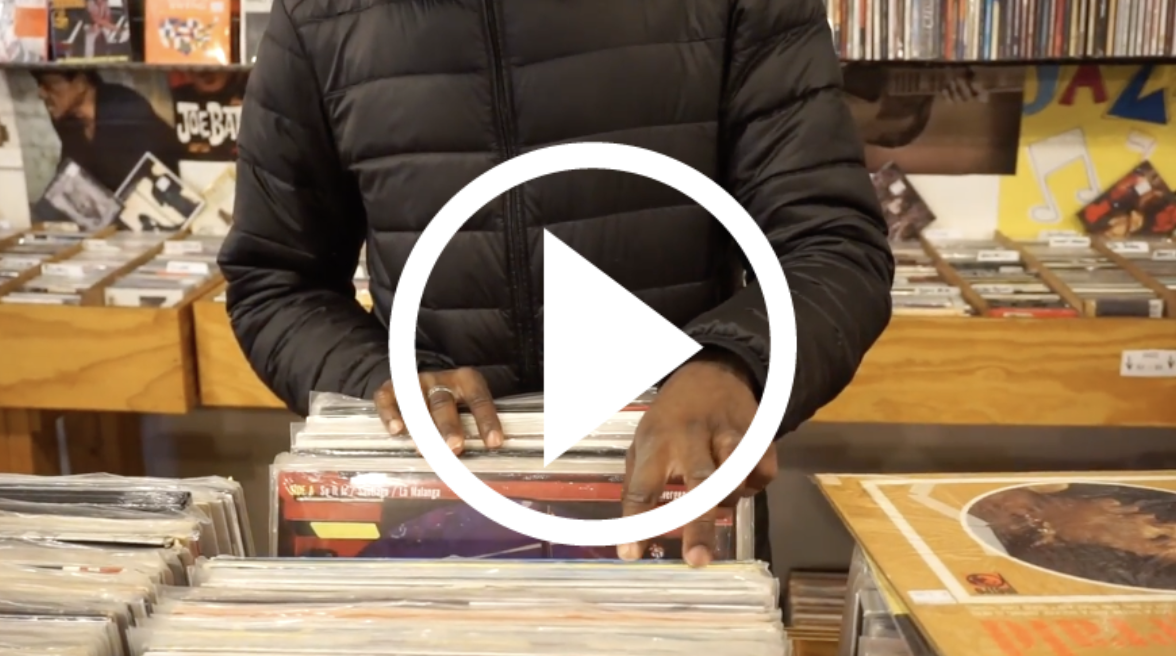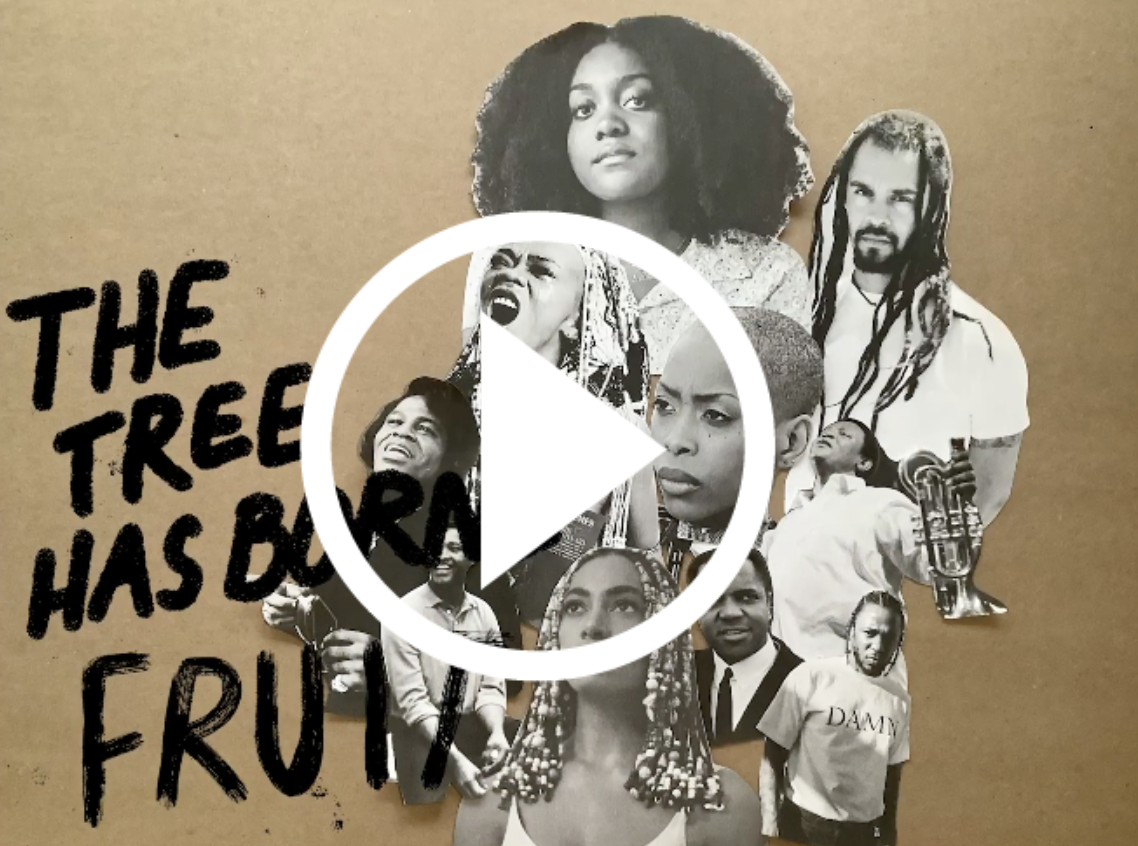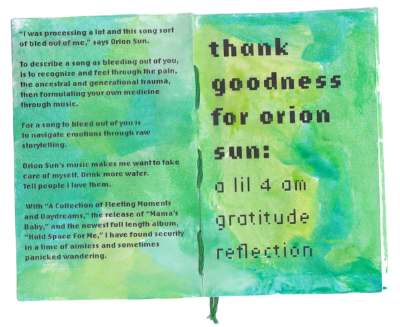Jenn Nkiru:
A Time Traveler of Black Spaces and Miner of the ArchiveDirector and black female auteur Jenn Nkiru fulfills the role of the artist, the creative, and the director in her approach to filmmaking. She warps time and evokes emotion in an unusual way, based on her personal history and relationship with the motion of time intertwined with the identity of being a black woman. Nkiru describes her films as “haptic, quite visceral, and dreamlike(The Gentlewoman).” Her work is the embodiment of “black magic in motion,” defying the limits of a linear timeline with her approach to using archival footage and altering speed of film.
Nkiru is a London-born Nigerian-British filmmaker and has beautifully documented the history and complicated identities of black people. She studied at Howard University in Washington, DC and received the 2018 Voice of A Woman Award from Cannes Film Festival in France. Through her work, she fulfills the role of the artist, the creative, and the director in her approach to filmmaking. She warps time and evokes emotion in an unusual way, based on her personal history and relationship with the motion of time intertwined with the identity of being a black woman. Nkiru’s films Black to Techno, En Vogue, and Rebirth is Necessary are great examples of her mastery in storytelling.
When describing the genre of afro-surrealism that many of her films lie in, Nkiru says, “It involves mining the archive, looking at different parts of history, and reconciling them to where we are now. I like to play with the perception and time, figuratively and literally (The Gentlewoman).” Nkiru’s three most recognizable and notable short films are En Vogue (2014), Rebirth is Necessary (2017), and Black to Techno (2019). “En Vogue” explores the art of voguing and ballroom dancing. Letterboxt describes it as “a high-concept in-your-face experimental short showcasing the unique beauty, energy, and exuberance of one of NYC’s last underground subcultures.” Her exploration of these subcultures is a common theme within her work. Her curiosity and desire to share the voices of people who are silenced or hidden is extremely clear. Rebirth is Necessary explores, as explained by Nkiru, “the idea of black universality.” It has been highly praised and was welcomed with open arms to the BlackStar Film Festival. Lastly, her most recent work, Black to Techno, reflects the Detroit techno scene. More than this, however, it explores the interconnectedness of the way this participation in techno music “ignited social and cultural revolution around the world before the turn of the century (MixMag).”
Not only was Rebirth is Necessary a part of the BlackStar Film Festival, it was also screened at Sundance Film Festival, the Royal Anthropological Institute Film Festival, and many others. Her films were also included in an experience put together by Solange Knowles called “Bridge-s” at the Getty Center in November 2019.
An important part of Jenn Nkiru’s identity and uniqueness as a director comes from her intensive interest in the creative process of other artists. She also clearly shows that she places value on supporting and connecting with other black artists. In her successes, she has interviewed and collaborated with many artists of varied expertise, Janelle Monae, Sampha, and Kamasi Washington to name a few. As the director of jazz musician Kamasi Washington’s 2018 music
video for “Hub-tones,” several of Nkiru’s repeated signature elements remain. In the first ten seconds, we are greeted by a gorgeous close up, slow-motion shot of a woman wearing a jeweled headpiece. She also has jewels glimmering on her skin, reminiscent of the last shot in Nkiru’s Rebirth is Necessary.
The Hub-tones music video carries on with a slowed 3 minute pan out, to which we begin to see more of the scene. This distortion and playing with time that Nkiru is noted for, occurs in the Hub-tones film. In an interview with The Gentlewoman’s journalist Richard O’Mahony, Nkiru explains how the film “was shot and lit at 48 frames per second, which is double the amount you would typically see a moving image, and then expanded into a nine minute film (The Gentlewoman).” This is a perfect example of how Nkiru manages this dreamlike quality. The subject remains in the center and two other dancers emerge to her left and right. There is a pan-African flag in the background, “designed to represent people of the African Diaspora, and, as one scholar put it, to symbolize "black freedom, simple (NPR).” She also collaborated with Kamasi Washington to create an alternative form of a music video, layering voices and expressing identity in “AS TOlD TO G/D THYSELF.”
In the past few years, she has collaborated with many other musicians and creatives. These people include Janelle Monae, for the New York Times Magazine project led by Nicole Hannah-Jones called “The 1619 Project: How Slavery Shaped America,” Beyonce Knowles for “APESHIT” and Ivy Park related content, a Neneh Cherry music video for “Kong”, and several others through music videos and other creative projects. Her film Rebirth is Necessary was screened prior to the London premiere of Black Panther. Nkiru’s work has had significant cultural relevance. She places emphasis on understanding the varied experiences of black people.
For example, in “Black to Techno” she explores the black experience in techno music throughout Detroit and many other cities inside and outside the United States.
In an interview with Rolien Zonneveld of Vice’s “i-D,” Jenn Nkiru describes her work as “cosmic archaeology.” This is a beautiful portrayal of her work, as the film does communicate history and contemporary life in a uniquely cohesive way. Zonneveld explains that from the age of 15, “she developed an interest in all things tinged with the supernatural, from Afrofuturism to her own complicated theory that human memory might be some cosmic energy.” Her approach is especially impactful because of her desire to “bridge the academy, pop culture and art.” Blending these mediums and outlets is what makes her work exhibit real life.
As she was secondary director of Beyonce’s “APESHIT” music video, it is clear to see how her art is used to make social commentary. Throughout, close crops of paintings are contrasted with the imagery of Beyonce and Jay Z singing, dancing, and owning their space in the Louvre. The contrast between the historic paintings and the presence and movements of Beyonce, Jay-Z, and the dancers create a commentary on the past and present.
The close up still shots of famous paintings are interspersed with footage of Beyonce and Jay-Z, joining and making commentary on past and present views of royalty and power. One of the introductory shots is a panning shot of the Louvre ceilings overplayed with flashing lights or red, blue, purple, and green. Modern, harsh lights combined with delicate and ornate ceiling paintings shows Nkiru defying time.
Another career highlight of Jenn Nkiru was her role as the second unit director of Beyonce and Jay-Z’s “APESHIT” music video. The role of the second unit director is to “capture all supplementary footage and maintain a look that is consistent with scenes filmed by the first
unit, ensuring continuity when the sequences are edited together in post-production (Get In Media),” giving Nkiru a unique opportunity to use her understanding of piecing together history with the present. With this, her perspective on time also shines through. As Beyonce and Jay-Z take up space in the Louvre in Paris, Nkiru still manages to chop up and rearrange the idea that time is linear. She cuts from time period to time period using her subject as well as the art throughout the museum.
One of the absolute most intriguing aspects of her approach to filmmaking is her understanding of time. “Nkiru’s personal films intentionally never take a linear approach to narrative. By playing hopscotch with western notions of time and space, she is making a point (The Financial Times),” explains Harriet Fitch Little of The Financial Times. In this interview, Nkiru goes on to explain how growing up with Nigerian family, time is perceived and understood differently, in a time where present and past are both merged and interchangeable. This approach to time brings power to her statements on the black experience, as well as brings her personal background and culture into her film making. It allows her to share what has changed and what has remained the same.
Nkiru was also recognized by the publication, Okay Africa as a part of their annual 100 Women campaign. The annual campaign “celebrates extraordinary women from Africa and the diaspora making waves across a wide array of industries, while driving positive impact in their communities and the world at large (Okay Africa).” It is safe to say that Nkiru fulfills this, as her work has served as a catalyst for several cultural moments.
Her impact has been recognized partly because Nkiru is a tremendous storyteller. In addition she is a master of time travel. She is a master of sampling, paying tribute, and
referencing the past through her film making. An example of this is in her most notable film, Rebirth is Necessary. As discussed previously, this film contains her signature element of time hopping. She is able to flawlessly stitch together archival footage, modern shots, professionally captured footage, and home movies to create a statement related to time and the state of black lives. In Nkiru’s film, Rebirth is Necessary, several quotes are listed, one of the most notable being “The black ecstatic cannot be contained.”
It is also important to note that Rebirth is Necessary is the title of a J Dilla song. J Dilla’s beats and lyrics have been extremely influential in the hip-hop realm and black community as a whole. In this song, he speaks on police violence and the black experience in Detroit. The opening line of the song reads, “Detroit is bleeding. If you’re young black and male, you’re more likely to die by violence than by any other cause.” He then goes onto make more commentary about police brutality and the system, as well as the impact of a community attacking itself. The reference to this J Dilla track in Nkiru’s film serves as a nod to his influence. Additionally, Nkiru conducts an interview with one of J Dilla’s relatives for her film, “Black to Techno,” which has many storylines based in Detroit, the hometown of J Dilla. Nkiru pays subtle tribute to J Dilla and his ideologies in this way.
Nkiru gives special attention to music and details in the audio component of her films. Simply the audio in her 2017 film Rebirth is Necessary is very effective in navigating time. In exploring strictly the audio, another notable sampling and referencing to the past pops up. A decision that I found extremely powerful was Nkiru’s use of the voice of Daniel Hamm from an interview documenting police brutality.
The quote flashes on the screen as Hamm says “I had to, like, open the bruise up, and let some of the bruise blood come out to show them.” This quote was popularized by a piece by composer Steve Reich. Steve Reich’s “Come Out” is an audio collage that is disorienting and jarring. As you listen to the almost 13 minutes of audio, however, it becomes rhythmic, then disjointed, and finally distorted before it fades to silence. The sampling of this audio collage in the Rebirth is Necessary film creates a timelessness because it references both the modern and historical issue of police brutality, specifically against the black community in the United States. The 1964 interview referenced was of Daniel Hamm, one of the members of the Harlem Six, who were brutally beaten by police, then almost refused medical attention. Their story reflects violence towards black people and a system designed to oppress, which is a layer explored in Jenn Nkiru’s film.
Similarly to Steve Reich’s audio collage, “Come Out,” Nkiru finds use of repetition. She not only repeats audio, but there are several instances in which she uses repetition for emphasis and to make a comment about history repeating itself. For example, Alice Coltrane is mentioned three times, as is the message “Black is beautiful.” These images are followed by another clip and the quote “Three screams from the edge of the earth.” Her film conveys so many contradicting feelings, thus expressing the complexity of life, especially as a black person.
Shortly after the recitation of the Daniel Hamm quote, Nkiru flashes a James Baldwin quote on the screen. It reads, “You have to go the way your blood beats.” The reference of blood once again connects the two quotes, and suggests some kind of healing and “rebirth” from history’s events.
In a panel hosted by AFROFREQUENCY’s “4:3” Project, Janelle Monae and Jenn Nkiru engage in a beautiful discussion about being an artist and creator. More specifically, being an artist and creator as black women in an industry and society working against them. Nkiru says, “Often times it is so easy because of the passing of time for us to forget origins.” This speaks again to her unique perspective on time and how she alters it in a way that helps us, as an audience, remember and reflect on past, present, and future.
Not only is the contrasting between archival footage and contemporary footage representative of time warping in Rebirth is Necessary, but time is also explored in a reoccurring scene of dancers in a city street. She also reverses some footage to obtain a similar effect. This could be implying that not much has changed within some of our communities, however, “without community there is no liberation.”
The scene described is from her 2017 film, Rebirth is Necessary. The film tells a collective story about the range of the black experience. It explores historic footage and more contemporary pieces collaged together in a cohesive way. The audio used also combines contemporary music and archival clips including reference to Sun Ra and more.
The particular scene in reference is from timestamp 7:58 to 8:37, at the end of the film. This scene is shown in various forms throughout the film, serving as a central element, however, at the end, it plays a slightly different role, that is to be discussed later. The repeated scene depicts several dancers on the sidewalks of a city. The street is empty besides the dancers, so all eyes are on them. The street is lined with several small shops that appear to be closed, including a carpet shop and a few convenient markets. The scene fades into a full tracking shot, moving backwards as the dancers move towards the camera. Their dancing is a beautiful combination of
fluid movements and more agitated movements. Regardless, each of them move with power and intention. They dance in front of storefronts and under scaffolding and subway platforms with large, deep purple poles.
One dancer wears a patterned purple shirt that flows loosely, while another dancer wears a structured bright orange jumpsuit, analogous colors. The third dancer wears a maroon patterned cloak-like piece of clothing, with hair braided and defying gravity. Two other dancers jump through the street in a more playful way than the other dancers, weaving in between objects in black and white patterned outfits. The scene ends with a reverse establishing shot, since it has been presented in reverse. The camera zooms out to the empty street as the dancers exit the scene. The zooming out occurs slowly and expansively to give slightly more context to the scene that just played out.
Another important note when observing this scene is the ambiguity of gender. Jenn Nkiru is seemingly very intentional about shedding light on the experiences of all black individuals. Through the portraits and showcases of each of these individuals we can identify a different background and story in each. These are stories reflecting race, gender, sexuality, environment, and more. The scene overall is extremely vibrant. The vibrancy mainly comes from the clothes and clear comfortability and spirit of the dancers. Colors in the background and setting are fairly muted. Dancing in an environment that is common and generic to many like a sidewalk, is suddenly turned into a stage for expression. The fact that it is performed in a public space like a city street communicates to the audience that the dancers’ art will not go unnoticed or unseen.
Then, the audience is brought back to the setting of the dancers on the sidewalk several times over the course of the ten and a half minute film, however, there is a major difference in
the particular scene being dissected. At the timestamp of 7:58 the dancers are played in reverse. They move towards the camera instead of away, put on jackets, and collect confetti that was thrown in previous scenes. Once again, Jenn Nkiru is playing with time. This most likely represents a lack of progress in society, reflecting on and acknowledging the past, or possibly both. It also presents an idea on perspective and movement.
The dancers, in a sense, represent this “rebirth” that Jenn Nkiru is proposing through the film. Throughout the scene, a warped, disoriented, muffled, and partially reversed beat driven track is played. An echoing group of voices sing: “Things will work out fine” as an almost spiritual voice of comfort. This scene was a turning point and served as a culmination of all things referenced in the film. Jenn Nkiru said "Creating this piece felt like therapy. It's where I got to reconcile my worlds—the material and the spiritual, the human and divine. This film is jazz; black magic in motion. I hope it can be a source of inspiration, affirmation and healing to others as it has been to me, especially the black diaspora." That’s exactly what this final scene accomplished. Using this reversed scene to reflect on this idea of rebirth and rediscovery of blackness is so important to the film and creating this “black magic.” Motion of the subjects in Nkiru’s films are given special attention. She uses dance and the body in a way that evokes emotion across all of her films. There is a uniquely beautiful contrast between etherial moments and the pain endured by black communities.
Jenn Nkiru describing this film as therapy is reflective of the nature of her work. She uses the bending of time as a unique transformative element and turning to history to heal and learn for the future. An Audre Lorde quote noted in Rebirth is Necessary states “Without community, there is no liberation. Community must not mean a shedding of our differences nor the pathetic pretense that these differences do not exist.” Through her film making, Jenn Nkiru creates community and an interconnectedness with the past unlike any other.
Sources / Bibliography
Editor, Spectrum. “Jenn Nkiru Visits ICA to Share Films That Explore Blackness through Music .” The Commonwealth Times, November 5, 2019. https://commonwealthtimes.org/2019/10/15/jenn-nkiru-visits-ica-to-share-films-that-explore- blackness-through-music/.
“Call & Response: Sampha & Jenn Nkiru on Rituals for Making Music.” 4:3, 2018. https:// fourthree.boilerroom.tv/film/call-response-sampha-x-jenn-nkiru.
Beta, Andy. “Blood and Echoes: The Story of Come Out, Steve Reich's Civil Rights Era Masterpiece.” Pitchfork. Pitchfork, April 28, 2016. https://pitchfork.com/features/article/9886- blood-and-echoes-the-story-of-come-out-steve-reichs-civil-rights-era-masterpiece/.
Tani, Ellen Y. “‘Come Out to Show Them’: Speech and Ambivalence in the Work of Steve Reich and Glenn Ligon.” Art Journal Open, March 6, 2020. http://artjournal.collegeart.org/?p=13202.
SaraJerde. “Janelle Monáe Narrates New York Times Ad for 1619 Project.” Adweek. Adweek, February 6, 2020. https://www.adweek.com/tv-video/janelle-monae-narrates-new-york-times-ad- for-the-1619-project/2/.
“Jenn Nkiru's Panafrican Imagination: Black Studies as Aesthetic Practice.” Hellenic Studies, April 9, 2019. https://hellenicstudies.gsu.edu/2019/04/09/jenn-nkirus-panafrican-imagination- black-studies-as-aesthetic-practice/.
Donnella, Leah. “On Flag Day, Remembering The Red, Black And Green.” NPR. NPR, June 14, 2017. https://www.npr.org/sections/codeswitch/2017/06/14/532667081/on-flag-day- remembering-the-red-black-and-green.
“Second Unit Director.” Get In Media, 2020, getinmedia.com/careers/second-unit-director.
“Movement and Technology: Jenn Nkiru Interviewed by Rianna Jade Parker - BOMB Magazine.” Movement and Technology: Jenn Nkiru Interviewed - BOMB Magazine, 9 Oct. 2019, bombmagazine.org/articles/movement-and-technology-jenn-nkiru-interviewed/.
thank goodness for orion sun: a lil 4am gratitude reflection
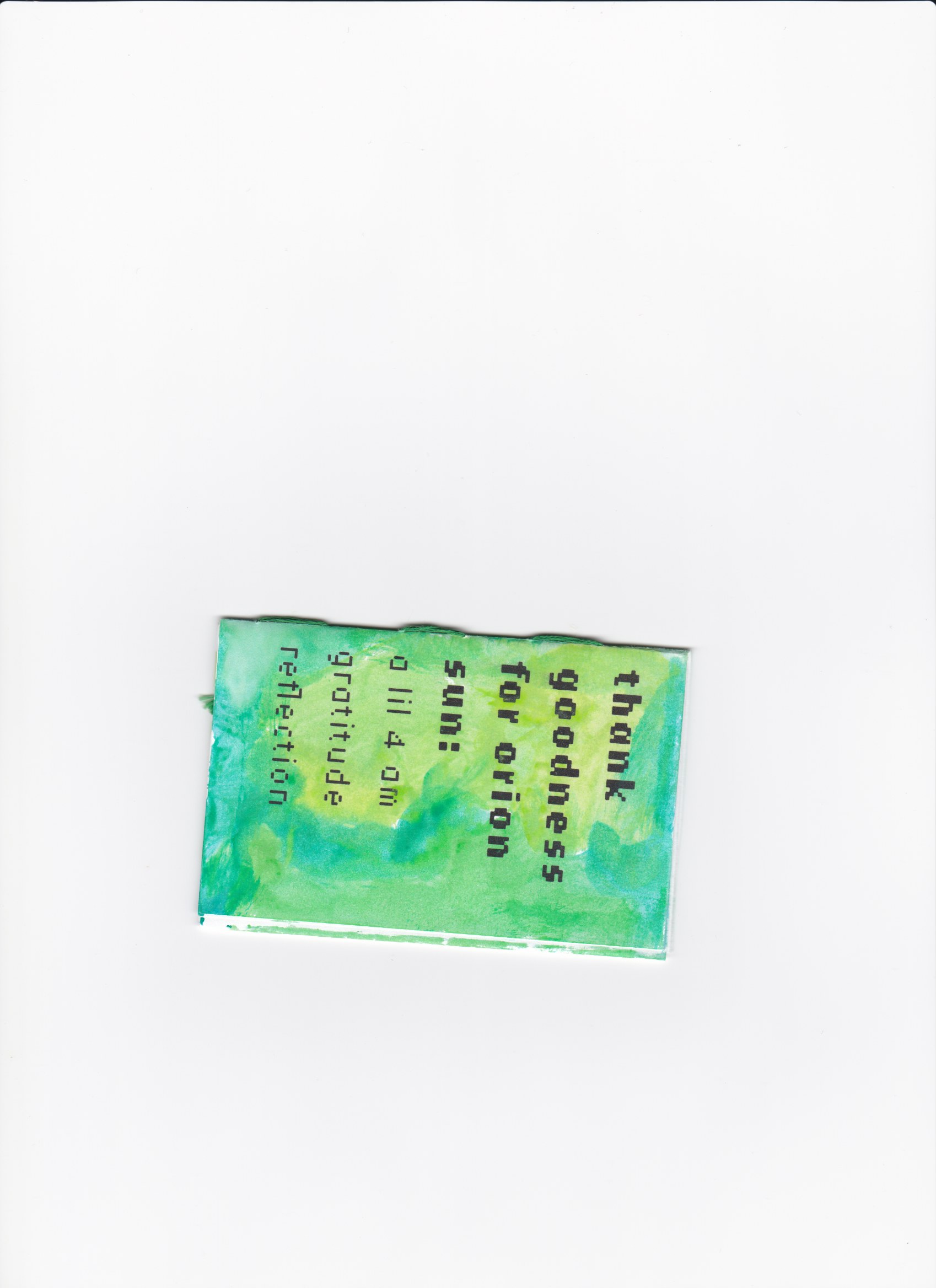
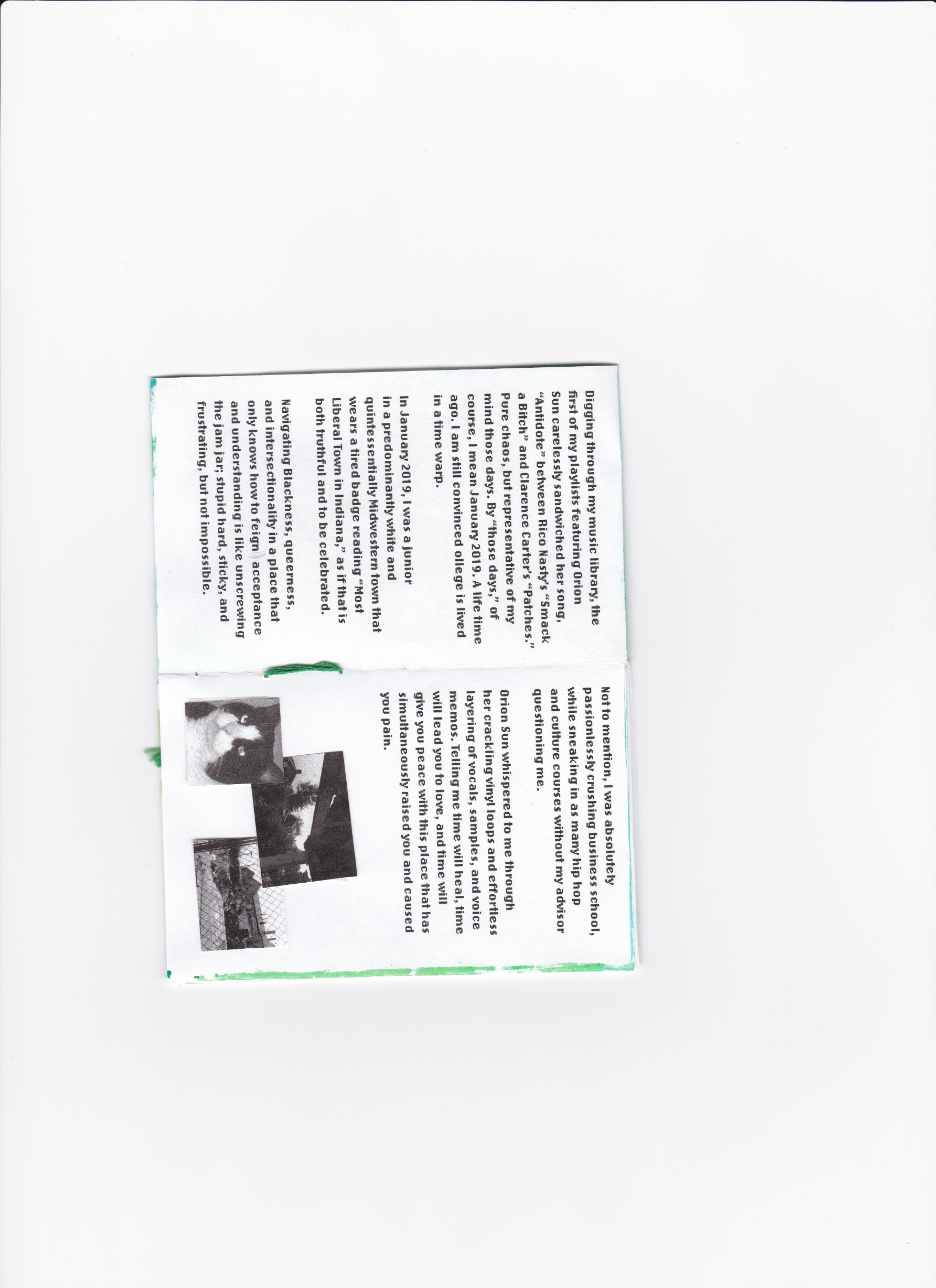
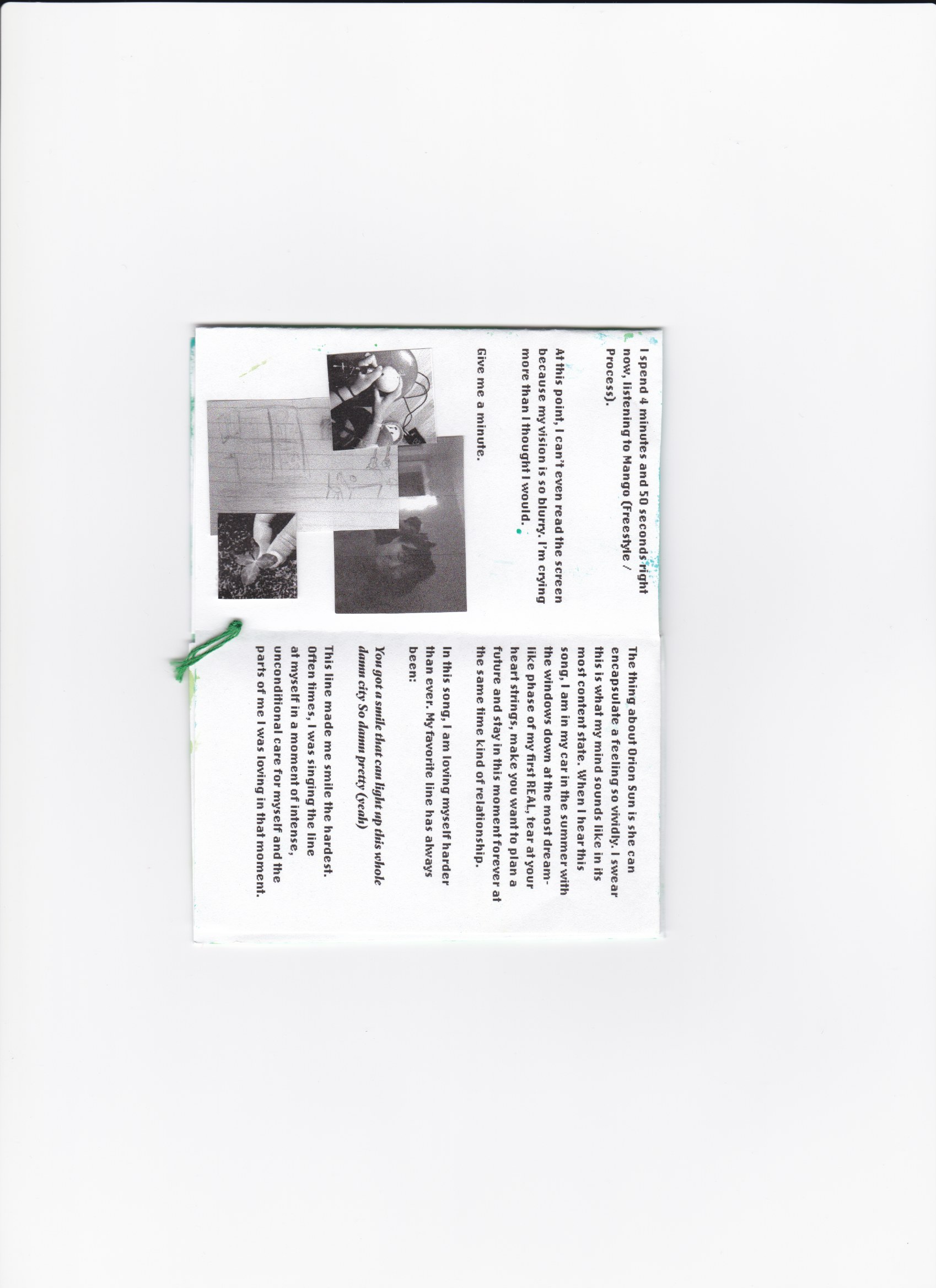








Sampling: A Thank You to the Greats
In the act of MCing, it is always important to pay tribute to the DJ as a form of
recognizing those that came before them and those that made the sharing of their art possible.
Just like MCing, sampling is a unique way of recognizing and showing gratitude towards the
past. Masters of funk, jazz, and R&B like James Brown and Miles Davis, paved the way for the
hip-hop community, and are still seen as heavy influences for contemporary hip-hop and R&B
artists like Kendrick Lamar and Erykah Badu. Sampling and mirroring styles is a form of thanks
and recognition given to those that came before.A large portion of the beginnings of hip-hop (and hip-hop now), was how the music made you move. In “Hip-Hop Drumming: The Rhyme May Define, but the Groove Makes You Move,” an essay by Jeff Greenwald for the Black Music Research Journal, he digs into what made a good song for the dance floor. Greenwald says, “The bass drum is important to the beat because it signifies movement on the dance floor, largely through matching the rhythm and sonic force of the bass.” This is the primary reason that James Brown’s “Funky Drummer” was so frequently used in DJ sets. This breakbeat was one so desirable that it has become “one of the most-sampled beats used in hip-hop music comes from James Brown’s “Funky Drummer” (1970), with Clyde Stubblefield on drums(Greenwald 261).”
The breakbeat and various elements of the track were sampled in N.W.A.’s “Fuck da Police(1988),” Public Enemy’s “Fight the Power(1988),” and countless more. James Brown’s track has been sampled across all genres, with artists including Sinead O’Connor, Mos Def, and Emeli Sande to name a few. Although, the genius of this breakbeat didn’t just arise out of nowhere.
James Brown’s “Funky Drummer” had “breaks that proved to be something of a goldmine (Early),” explains N. Ali Early. In an article by Early, entitled “Hip-Hop Records Sampled James Brown. His First Funk Record Sampled Miles Davis,” he discusses the development of funk music out of jazz. He also tells the remarkable story of the creation of James Brown’s “Cold Sweat,” another track with a contagious breakbeat. In the songwriting process, one of James Brown’s band members mentioned the song being heavily influenced by Miles Davis’ “So What” from the Kind of Blue record. More specifically, he referenced the “dee dumph” cadence of the notes that serve as the song’s backbone.
There is a Miles Davis quote that reads, “Sometimes you have to play a long time to be able to play like yourself.” This speaks to both the power of artistic influences as well as the power allotted to creating art unique to oneself. To me, the journey of an artist’s creation of music is comparable to the journey of raising a kid. My mom always said that raising a child takes a village. It’s the same with songwriting. You must consult the past, present, and future, consider your community and environment, as well as genuine personal perspectives and identities. Erykah Badu does this flawlessly.
Her song “Rimshot (Intro),” on her album live 1997 album, is quintessential and representative of the Badu sound. However, upon first listen, there is a subtle nod to Miles Davis. The same two notes that are played with for the entirety of Miles Davis’ “So What” from the Kind of Blue record. What’s interesting is in this same detail, Badu was thanking James Brown as well, giving a nod to those that helped define her genre and space in the industry.
With sampling, often comes the intention of politicizing a song, or communicating the context to the listener. Tricia Rose writes in her book, Black Noise: Rap Music and Black Culture in Contemporary America, a very important point about the act of sampling. Discussing the MCing of Grandmaster Flash, Rose says “using multiple samples as dialogue, commentary, percussive rhythms, and counterpoint, Flash achieved a level of musical collage and climax with two turntables that remains difficult to attain on advanced sampling equipment ten years later (Rose 54).” This “musical collage” to communicate with listeners is still prominent. Kendrick Lamar’s 2017 album, DAMN exemplifies this. He reflects on his identity and his journey with his community and the media’s influence. This album is representative to many as a major political rap album. On the first track on the album, “BLOOD,” the song ends with an alternative, but very strong sample from a Fox News show. In the clip, the two white, conservative news anchors are critiquing Lamar’s song “Alright,” which has been at the epicenter of the Black Lives Matter Movement. The quoted portion of their discourse is: “Uh, Lamar stated his views on police brutality with that line in the song, quoted ‘and we hate the popo, wanna kill us in the street fo' sho.’ Oh please, ugh, I don't like it.”
For NPR, Andrew Limbong writes about the importance of “Alright” in his article, “Both Party And Protest, ‘Alright’ Is The Sound of Black Life’s Duality.” In the article, Limbong notes Miles Marshall Lewis saying that ‘Alright’ embodies “the ancestors who never received the justice they deserved (NPR).” The inclusion of the Fox News sample speaks to the society we live in today and how he won’t be hindered by voices like this. It also shows that Lamar will always reclaim his own dialogue and won’t let others speak for it.
Interestingly enough, the last track on DAMN, which is “DUCKWORTH,” reveals some of Kendrick’s genuine struggles using samples as an assist to communicate. The song opens with the following lyrics:
“It was always me vs the world Until I found it’s me vs me Why, why, why, why?
Why, why, why, why?
Just remember what happens on earth stays on earth! We gon' put it in reverse.”
In exploring the first two lines, it seems to be commentary on internal versus external challenges. Lamar is alluding to his troubles within his own self as well as in his own community.. Tricia Rose comments on this being an important aspect of hip-hop, stating:
“Like the consciousness-raising sessions in the early stages of the women’s rights movement and black power movement of the 1960s and 1970s, hip hop produced internal and external dialogues that affirmed the experiences and identities of the participants and at the same time offered critiques of larger society that were directed to both the hip hop community and society in general (Rose 60).”
These internal and external dialogues are challenging, but critical to the social and
political goals that are often attached and communicated through hip-hop. The line, “we gon’ put it in reverse,” also references time and acknowledges our pasts. When he shouts this out, it is in the manner of an MC, right before the sample begins playing. Seconds later, we hear Ted Taylor’s “Be Ever Wonderful (1978).” Taylor sings,
“Darling, I told you many times
And I am telling you once again
Just to remind you, sweetheart
That my love for you has never changed.”
This sample repeats in different forms, often chopped and underlaid with the instrumental, throughout the song. It has a nostalgic air to it that makes Lamar’s storytelling in “DUCKWORTH” extremely effective and compelling. The role of the sample is to serve as a reminder as times past, as he says “just to remind you.” In the DISSECT podcast hosted by Cole Cuchna, he emphasizes the work of Kendrick being highly influenced by the fact that he strongly believes in the “transformative power of music (Dissect Podcast Season 5 Episode 19).”
Sampling has become vital to the livelihood of the hip-hop community today. It allows the past to live on. And as is quoted by a Tupac figure in the concluding track of Lamar’s To Pimp a Butterfly, “Mortal Man,” “because it’s spirits, we ain’t even really rappin’. We just letting our dead homies tell stories for us.” Acknowledging the past, creating in the present, and allowing our ancestors in hip-hop to help inform our future is a grand aspect of the community. Because of this, the greats will live on and their music will continue to shape our world.
Sources / Bibliography
Tricia Rose Black Noise: Rap Music and Black Culture in Contemporary America
https://www.whosampled.com/Kendrick-Lamar/DUCKWORTH./
https://www.npr.org/2019/08/26/753511135/kendrick-lamar-alright-american-anthem-party-protest
https://www.rttnews.com/2508612/kendrick-lamar-says-he-studied-james-brown-for-king-kunta.aspx ?refresh=1
https://www.liveabout.com/how-james-brown-influenced-hip-hop-2857334
https://www.newyorker.com/magazine/2016/04/25/erykah-badu-the-godmother-of-soul
Dissect Podcast Season 5
https://genius.com/Kendrick-lamar-duckworth-lyrics
https://ambrosiaforheads.com/2018/12/james-brown-samples-miles-davis/
https://www.rollingstone.com/music/music-news/james-brown-most-sampled-man-in-the-biz-115 798/


